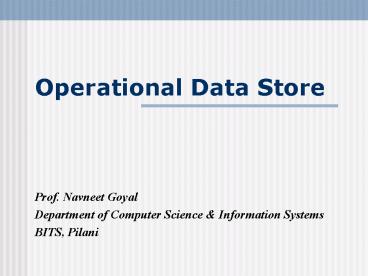Operational Data Store - PowerPoint PPT Presentation
1 / 16
Title:
Operational Data Store
Description:
Operational Data Store Prof. Navneet Goyal Department of Computer Science & Information Systems BITS, Pilani ODS An operational data store (ODS) is a type of database ... – PowerPoint PPT presentation
Number of Views:68
Avg rating:3.0/5.0
Title: Operational Data Store
1
Operational Data Store
- Prof. Navneet Goyal
- Department of Computer Science Information
Systems - BITS, Pilani
2
ODS
- An operational data store (ODS) is a type of
database often used as an interim area for a data
warehouse. - ODS Is highly volatile
- An ODS is designed to quickly perform relatively
simple queries on small amounts of data (such as
finding the status of a customer order) - An ODS is similar to your short term memory in
that it stores only very recent information in
comparison, the data warehouse is more like long
term memory in that it stores relatively
permanent information.
3
ODS
Figure taken from The Operational Data
StoreDesigning the Operational Data Store, By
Bill Inmon, DM Review, July 1998
4
ODS
Figure taken from The Operational Data StoreBy
Bill Inmon, INFO DB, 1995
5
ODS
- In Figure 1 the ODS is seen to be an
architectural structure that is fed by
integration and transformation (i/t) programs.
These i/t programs can be the same programs as
the ones that feed the data warehouse or they can
be separate programs. - The ODS, in turn, feeds data to the data
warehouse.
6
ODS
- According to Inmon, an ODS is a
"subject-oriented, integrated, volatile, current
valued data store, designed to serve operational
users as they do high performance integrated
processing. - In the early 1990s, the original ODS systems were
developed as a reporting tool for administrative
purposes
7
ODS
- Subject-oriented
- Customer, product, account, vendor etc.
- Integrated
- Data is cleansed, standardized and placed into a
consistent data model - Volatile
- UPDATEs occur regularly, whereas data warehouses
are refreshed via INSERTs to firmly preserve
history - Current valued
- Changes are made almost with zero latency
8
Classification of ODS
9
ODS
- ODS is also referred to as Generation 1 DW
- Separate system that sits between source
transactional system DW - Hot extract used for answering narrow range of
urgent operational questions like - Was the order shipped?
- Was the payment made?
- ODS is particularly useful when
- ETL process of the main DW delayed the
availability of data - Only aggregated data is available
10
ODS
- ODS plays a dual role
- Serve as a source of data for DW
- Querying
- Supports lower-latency reporting through creation
of a distinct architectural construct
application separate from DW - Half operational half DSS
- A place where data was integrated fed to a
downstream DW - Extension of the DW ETL layer
11
ODS
- ODS has been absorbed by the DW
- Modern DWs now routinely extract data on a daily
basis - Real-time techniques allow the DW to always be
completely current - DWs hav become far more operational than in the
past - Footprints of conventional DW ODS now overlap
so completely that it is not fruitful to make a
distinction between the kinds of systems
12
ODS
- Classification of ODS based on
- Urgency
- Class I - IV
- Position in overall architecture
- Internal or External
13
A Word About ODS
- Urgency
- Class I Updates of data from operational
systems to ODS are synchronous - Class II Updates between operational
environment ODS occurs between 2-3 hour frame - Class III synchronization of updates occurs
overnight
14
A Word About ODS
- Urgency
- Class IV Updates into the ODS from the DW are
unscheduled - Data in the DW is analyzed, and periodically
placed in the ODS - For Example Customer Profile Data
- Customer Name ID
- Customer Volume High/low
- Customer Profitability High/low
- Customer Freq. of activity very freq./very
infreq. - Customer likes dislikes
15
ODS
16
ODS Real-Time Data Warehousing
- Which class of ODS can be used for RTDWH?
- HOW?
- Let us first look at what we mean by RTDWH
- Next Lecture on RTDWH

